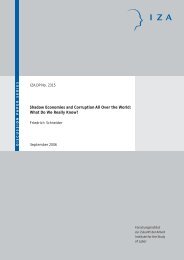Gender Differences in Education Tuomas Pekkarinen - Index of - IZA
Gender Differences in Education Tuomas Pekkarinen - Index of - IZA
Gender Differences in Education Tuomas Pekkarinen - Index of - IZA
You also want an ePaper? Increase the reach of your titles
YUMPU automatically turns print PDFs into web optimized ePapers that Google loves.
However, it seems to be unambiguously true that the rates <strong>of</strong> returns comparisons mask large<br />
differences <strong>in</strong> favor <strong>of</strong> men <strong>in</strong> total earn<strong>in</strong>gs benefits <strong>of</strong> university education. Women still<br />
work less hours over the life cycle than men at all levels <strong>of</strong> education. Hence, even if there are<br />
no large differences <strong>in</strong> university premiums between men and women, men are still <strong>in</strong> a better<br />
position to reap the full f<strong>in</strong>ancial benefits <strong>of</strong> university education than women.<br />
Yet, <strong>in</strong> this respect changes over the past decades have been substantial. Female labor force<br />
participation has <strong>in</strong>creased considerably <strong>in</strong> all OECD countries s<strong>in</strong>ce the 1970’s. The capacity<br />
<strong>of</strong> women to fully benefit from the f<strong>in</strong>ancial rewards <strong>of</strong> educational <strong>in</strong>vestments has therefore<br />
improved <strong>in</strong> the recent decades. Moreover, as reported by Mulligan and Rub<strong>in</strong>ste<strong>in</strong> (2008),<br />
the composition <strong>of</strong> female labor force has changed. Whereas the selection <strong>in</strong>to female labor<br />
force was negative <strong>in</strong> the past <strong>in</strong> the sense that lower educated women had a higher<br />
probability <strong>of</strong> participat<strong>in</strong>g than high educated women, s<strong>in</strong>ce the 1980’s selection has become<br />
positive so that high educated women are more likely to participate <strong>in</strong> the labor force.<br />
In the same way as higher labor force participation has <strong>in</strong>creased the benefits <strong>of</strong> education for<br />
women also the chang<strong>in</strong>g role <strong>of</strong> family has improved the chances <strong>of</strong> women to reap the<br />
benefits from educational <strong>in</strong>vestments. Median age at first marriage has <strong>in</strong>creased <strong>in</strong> virtually<br />
all <strong>in</strong>dustrialized countries. At the same time, divorce rates have <strong>in</strong>creased mak<strong>in</strong>g marriage<br />
more fragile. As a consequence the fraction <strong>of</strong> lifetime that <strong>in</strong>dividuals spend married has<br />
decreased substantially. This has meant that the value <strong>of</strong> economic <strong>in</strong>dependence has<br />
<strong>in</strong>creased for women and the time dur<strong>in</strong>g which they can benefit from educational<br />
<strong>in</strong>vestments <strong>in</strong> the form <strong>of</strong> labor market returns has become longer.<br />
14
















